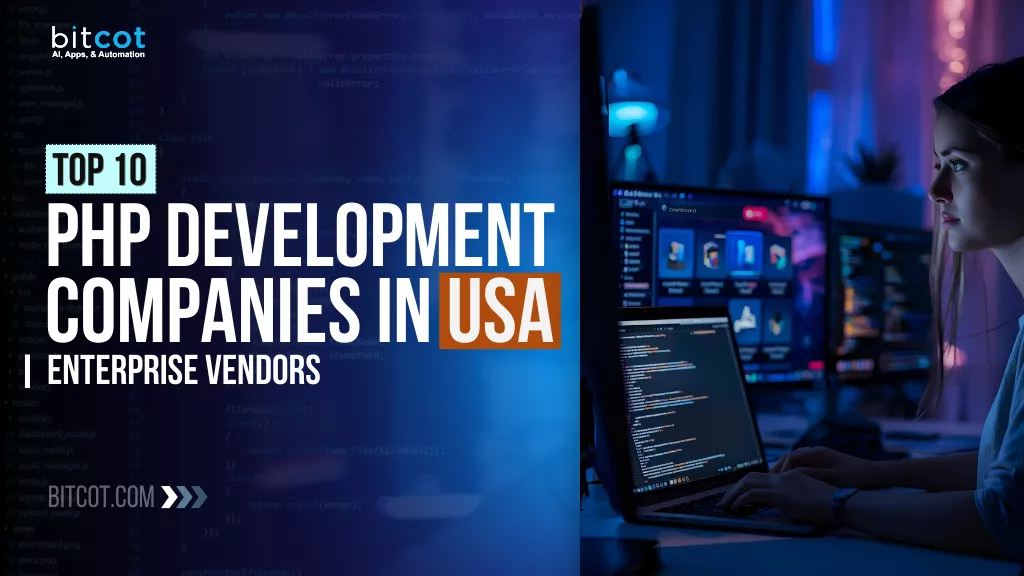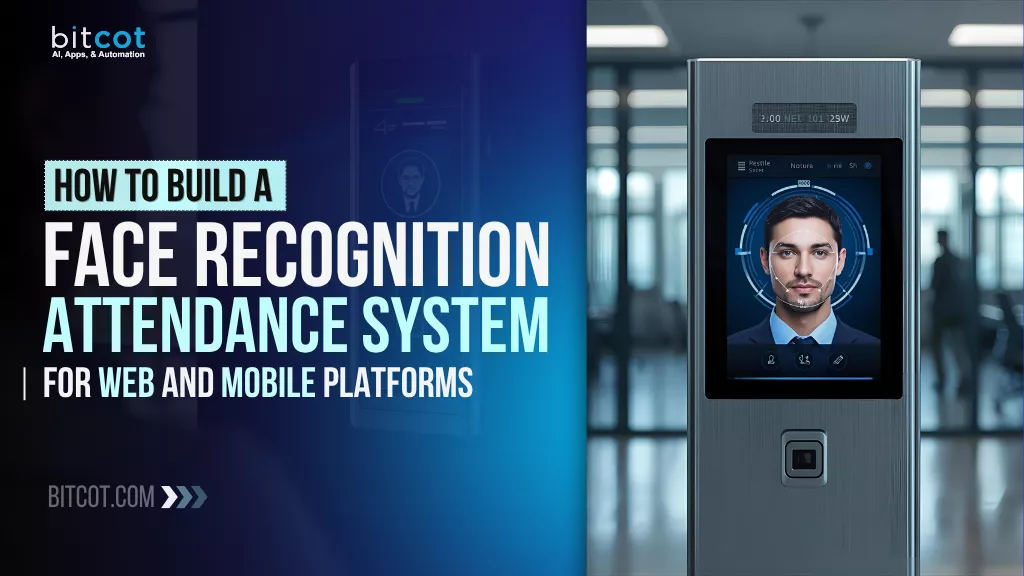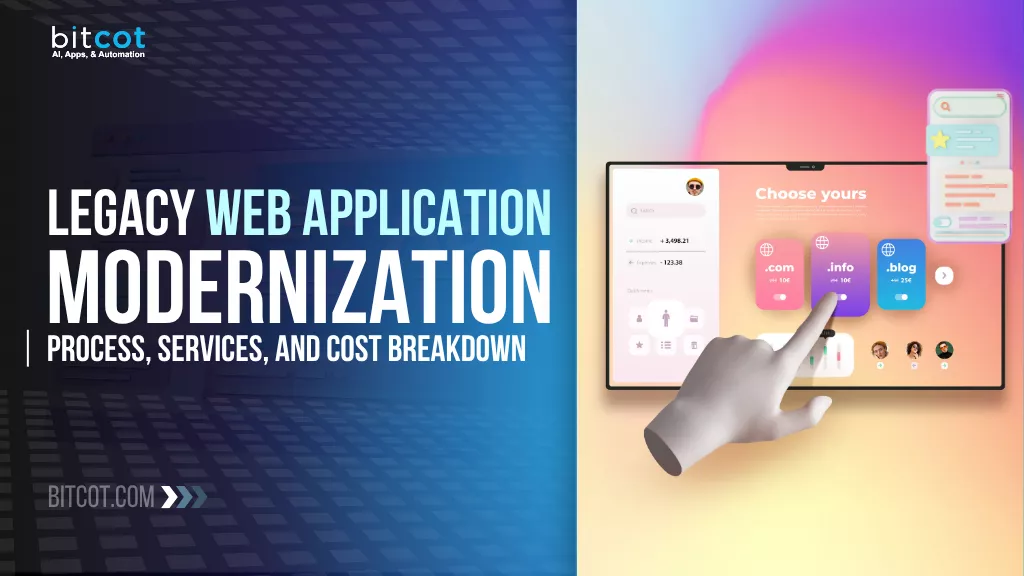
If your web application has been running for years, maybe even powering your business since the early 2000s, it’s probably starting to show its age.
Slow loading speeds, clunky interfaces, security vulnerabilities, difficulty adding new features, and rising maintenance costs are all red flags. And yet, completely replacing the system feels expensive, risky, and overwhelming.
Sound familiar?
That’s where legacy web application modernization comes in.
Instead of throwing everything out and starting from scratch, you upgrade, optimize, and re-architect the parts that matter, so your app performs like something built today, not a decade ago.
In this blog, we’ll break it all down in a simple and practical way:
- What the modernization process actually looks like (without the jargon),
- The key services involved and who handles what,
- And a clear cost breakdown, so you know what to expect before diving in.
By the end, you’ll know exactly when legacy web app modernization makes sense, how it works, and what kind of investment it typically involves.
Let’s get into it!
What is Legacy Web Application Modernization?
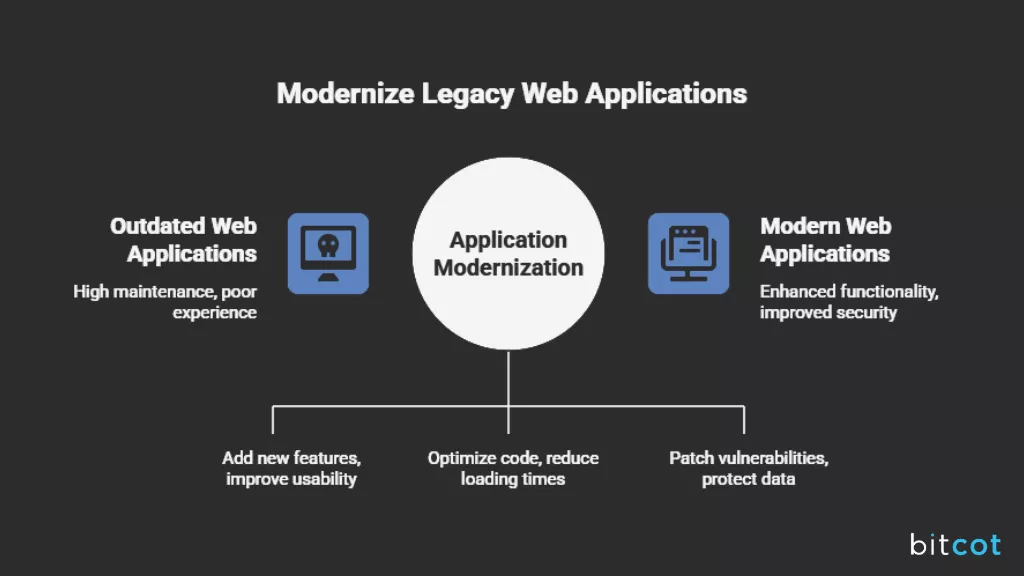
Legacy web application modernization is the process of transforming an outdated, hard-to-maintain application into a modern, efficient, and scalable version, without losing the core functionality your business depends on.
Think of it like renovating a house you’ve lived in for years. The structure may still be solid, but the wiring is old, the kitchen layout doesn’t work anymore, and the maintenance costs keep piling up.
Modernization doesn’t mean tearing everything down; it means upgrading what’s outdated so the whole system works better for today’s needs and tomorrow’s demands. It’s about preserving what works, replacing what doesn’t, and setting up the foundation for future improvements.
Here’s what legacy application migration can involve, depending on your app’s condition and goals:
- Upgrading outdated technologies (like moving from ASP.NET Web Forms to .NET Core, or from PHP 5 to Laravel)
- Rebuilding the frontend with modern frameworks like React, Angular, or Vue
- Migrating legacy applications to the cloud for better scalability and lower infrastructure costs
- Improving security and compliance to protect data and users
- Refactoring the codebase to fix inefficiencies and reduce technical debt
- Re-architecting for performance and future growth
- Legacy web app modernization redesign involving modern UI/UX redesigns
- Integrating APIs and third-party services to support new features and automation
The goal is to give your application a new life, making it faster, more secure, easier to update, and capable of supporting future features and integrations. Instead of fighting with outdated tech, your team can move forward with confidence and focus on innovation rather than maintenance headaches.
Modernization isn’t a one-size-fits-all project. It can be as light as updating the UI or as deep as replatforming and rebuilding key components of the backend. The approach depends on your business goals, budget, compliance requirements, user expectations, and how critical the current app is to day-to-day operations.
Whether you’re running a tech startup in San Francisco or an established enterprise in Los Angeles, the principles of modernization and enterprise application development apply across California and the broader USA.
Benefits of Legacy Web Application Modernization
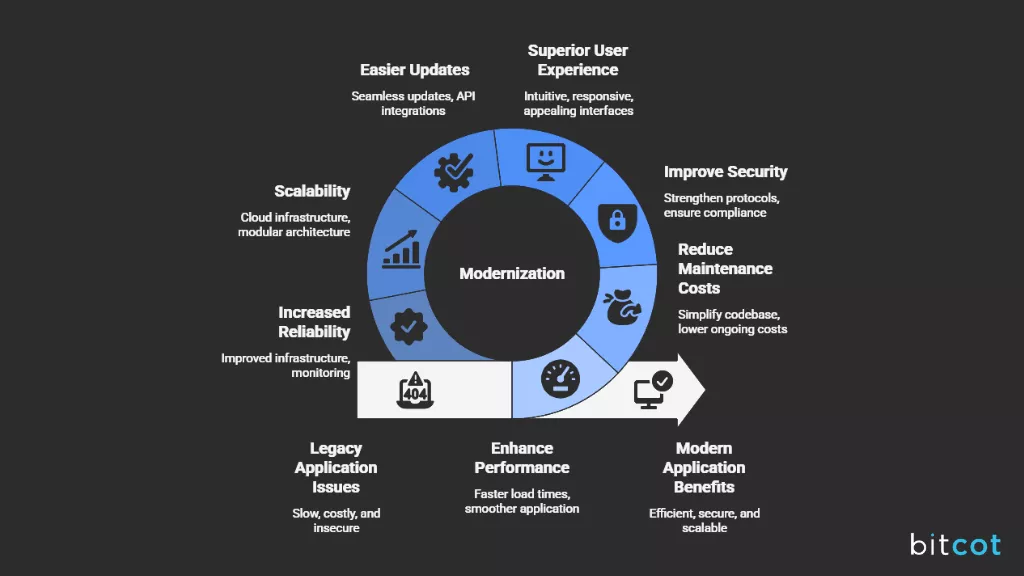
Modernizing your legacy web application isn’t just about updating old technology; it’s about giving your business a boost in efficiency, security, and growth potential.
From faster performance to better user experiences, legacy application modernization services deliver measurable advantages that keep your application relevant and competitive.
Enhanced Performance and Faster Load Times
Legacy applications often struggle with slow page loads, delayed data processing, and laggy user interactions because of outdated frameworks and infrastructure. Modernization optimizes the architecture, streamlines the codebase, and leverages current technologies, resulting in a faster, smoother application that can handle higher traffic without crashing or slowing down.
Businesses in San Diego have reported significant performance improvements after modernization, with page load times dropping by 60-70%.
Reduced Maintenance Costs and Technical Debt
Maintaining an old system can be expensive and time-consuming, often requiring specialized developers and frequent patches. By modernizing, you simplify the codebase, reduce technical debt, and lower ongoing maintenance costs, freeing your IT team to focus on innovation instead of constantly troubleshooting legacy issues.
Improved Security and Compliance
Older systems are more vulnerable to cyberattacks and often don’t meet current compliance standards. Modernization strengthens your security protocols, implements robust authentication, and ensures alignment with industry regulations. This protects sensitive data, reduces the risk of breaches, and keeps your business compliant with evolving legal requirements.
Organizations in San Jose dealing with sensitive customer data find this benefit particularly crucial.
Superior User Experience (UX)
Users today expect intuitive, responsive, and visually appealing interfaces. Modernization allows you to redesign the UI/UX with mobile-first design principles, interactive features, and smooth navigation. A better user experience increases engagement, improves retention, and builds customer loyalty, keeping your application relevant and enjoyable.
Easier Feature Updates and Integrations
Legacy systems can make adding new features or integrating with third-party services difficult. Modernization enables seamless updates, API integrations, and automation of key processes. This flexibility accelerates innovation, allows quick adaptation to changing business needs, and ensures your application can grow with your organization.
Companies in Fresno have successfully leveraged modernization to integrate modern payment gateways and analytics tools.
Scalability and Future Readiness
As your business grows, your application needs to scale. Modernized systems leverage cloud infrastructure, modular architecture, and efficient workflows, allowing your application to expand without major disruptions. This future-ready approach supports new markets, more users, and evolving business requirements with ease.
Increased Reliability and Uptime
Downtime and server crashes are common issues in legacy systems. Modernization improves infrastructure, monitoring, and system performance, resulting in higher reliability. Teams and customers can depend on the application consistently, which enhances productivity and trust in your digital platform.
Businesses in Sacramento have achieved 99.9% uptime after successful modernization projects.
Understanding the Process of Modernizing Legacy Web Apps
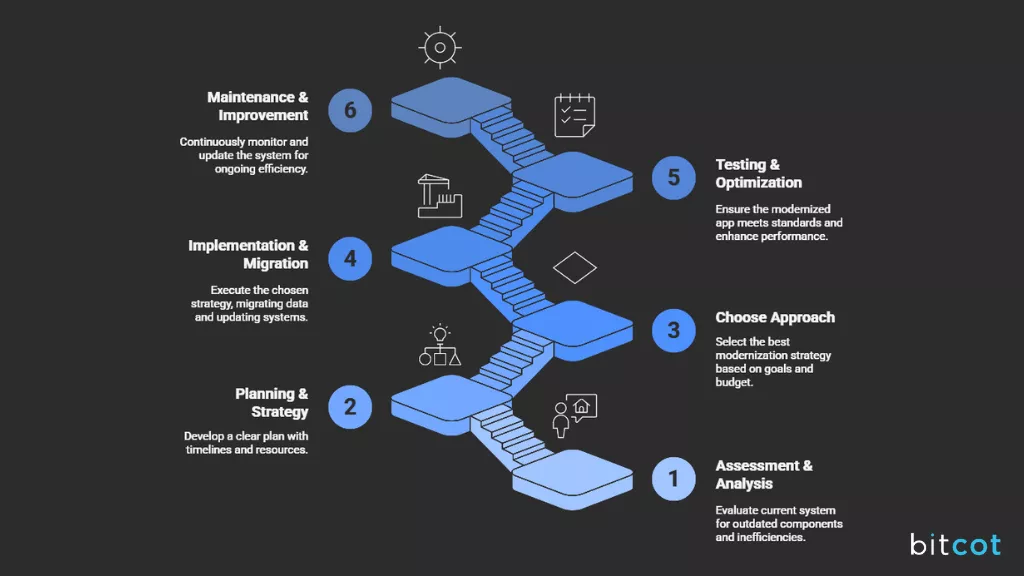
Modernizing a legacy web application may seem daunting, but breaking it down into clear steps makes the process manageable.
Think of it like planning a home renovation: you first assess what’s working, decide what needs updating, and execute improvements carefully to avoid disruption.
Similarly, legacy web app modernization focuses on upgrading outdated technology, improving performance, and preparing the system for future growth, all without interrupting business operations.
1. Assessment and Analysis
The first step is understanding your existing system in detail. This involves analyzing the application’s architecture, technology stack, code quality, performance metrics, and security vulnerabilities. Beyond the technical side, it also requires evaluating business processes, user behavior, and compliance requirements.
By identifying which parts of the system are outdated or inefficient, businesses can decide whether to refactor, rebuild, or replace certain components. For example, a company running an old PHP 5-based app may need to migrate to Laravel to maintain compatibility and improve security.
2. Planning and Strategy
Once the assessment is complete, a clear modernization strategy, including a cloud migration strategy is created, usually by a legacy web app modernization development firm. This plan defines the approach, timeline, resources, and budget. It also considers potential risks and outlines mitigation strategies.
A strong plan ensures that modernization aligns with business goals while minimizing downtime or disruption. Planning also involves prioritizing updates based on impact, cost, and urgency, critical for applications that support revenue-generating operations. Organizations in Long Beach have found that thorough planning reduces project risks by up to 40%.
3. Choosing the Right Modernization Approach
Not every application requires a full rebuild. Modernization strategies typically include:
- Rehosting (Lift and Shift): Migrate applications to the cloud or a modern server environment without altering their core functionality.
- Replatforming: Upgrading certain components, frameworks, or infrastructure to take advantage of modern technologies.
- Refactoring: Rewriting inefficient or outdated code to improve performance, maintainability, and scalability.
- Rebuilding: Redeveloping the application from scratch while keeping key business logic intact, often ideal for apps with multiple technical limitations.
The choice depends on the business’s goals, budget, timeline, and criticality of the application.
4. Implementation and Migration
Implementation involves executing the chosen strategy. This may include migrating databases, rewriting backend logic, updating front-end frameworks, integrating APIs, or deploying the app to cloud infrastructure. Phased migration is often used to ensure continuity, allowing users to access critical features while updates occur in the background.
Companies in Oakland typically adopt phased approaches to minimize disruption to daily operations.
5. Testing, Optimization, and Deployment
After migration, rigorous testing ensures the modernized application meets functional, performance, and security standards. Optimization includes performance tuning, load balancing, and UX enhancements. Deployment may occur gradually, often starting with a pilot phase, to minimize disruptions and gather user feedback.
6. Ongoing Maintenance and Continuous Improvement
Modernization doesn’t stop once the application is deployed. Continuous maintenance and improvement are critical to ensure the system remains secure, efficient, and aligned with evolving business needs. This involves regular monitoring of performance metrics, security audits, bug fixes, and updating dependencies to prevent vulnerabilities.
Key Services Offered in Legacy Web App Modernization Projects
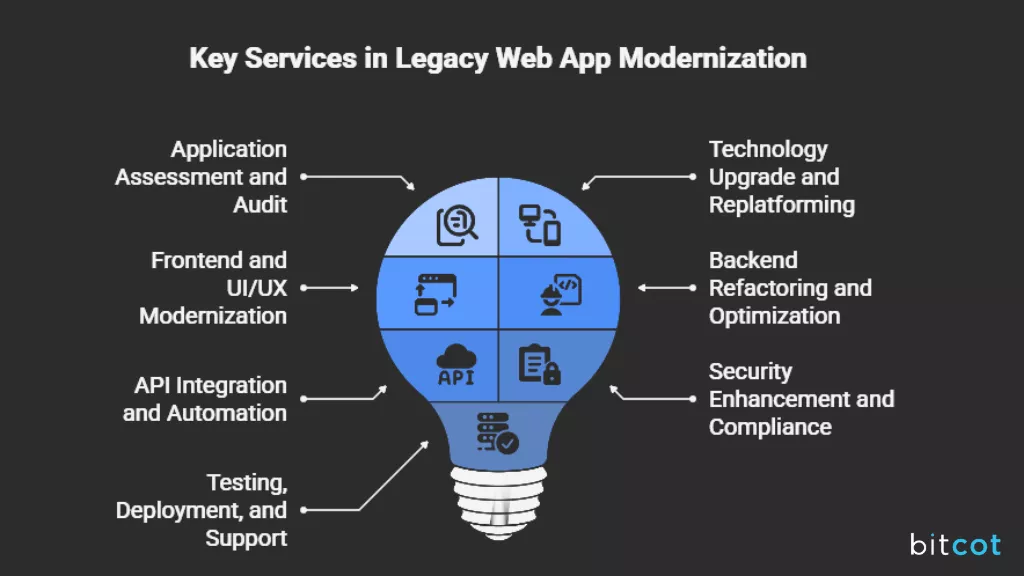
Modernizing a legacy web application requires a combination of technical expertise, strategic planning, and business insight. The process involves multiple specialized services that work together to transform outdated systems into modern, high-performing solutions.
Here’s a detailed look at the key services typically offered when modernizing legacy web applications:
1. Application Assessment and Audit
The first step in any modernization project is a thorough audit of the existing application. Experts evaluate the codebase, architecture, database, integrations, and infrastructure to identify inefficiencies, outdated technologies, and potential security gaps.
This service also includes understanding business goals and user needs, which ensures the modernization strategy is aligned with organizational objectives. A detailed assessment helps prioritize updates and reduces risks during the modernization process. Firms in Bakersfield often discover significant technical debt during this phase that would have caused major issues if left unaddressed.
2. Technology Upgrade and Replatforming
Upgrading outdated technology is a core service in modernization. This can include moving from old frameworks like ASP.NET Web Forms or PHP 5 to modern platforms such as .NET Core or Laravel. Replatforming may also involve migrating from on-premise servers to cloud solutions like AWS, Azure, or Google Cloud.
These upgrades improve performance, security, scalability, and maintainability, preparing the application for future growth and reducing ongoing operational costs.
3. Frontend and UI/UX Modernization
Modernizing the user interface is essential for improving user satisfaction and engagement. This service includes redesigning the frontend with modern frameworks such as React, Angular, or Vue, creating responsive layouts, and optimizing the overall user experience.
By improving navigation, accessibility, and aesthetics, businesses can ensure that their application meets the expectations of today’s users across web and mobile platforms, boosting retention and satisfaction. Companies in Anaheim have seen user engagement increase by 50% after implementing modern, intuitive interfaces.
4. Backend Refactoring and Optimization
Refactoring the backend is like tuning the engine of your application. This service focuses on cleaning up legacy code, restructuring databases, and optimizing business workflows.
A well-refactored backend improves application speed, maintainability, and scalability while reducing technical debt. It also simplifies future updates, integrations, and feature additions, making the system more flexible and capable of supporting evolving business requirements.
5. API Integration and Automation
Modern applications must communicate seamlessly with external systems and services. API integration services for legacy systems connect your application to third-party tools, cloud services, and internal systems, enabling automated workflows and smooth data exchange.
This reduces manual effort, streamlines processes, and increases operational efficiency. By integrating automation, businesses can save time, reduce errors, and expand the application’s functionality without major redevelopment. Organizations in Stockton have automated 70% of their manual processes through strategic API integration.
6. Security Enhancement and Compliance
Security and compliance are critical in modernization projects. This service includes implementing advanced authentication, encryption, vulnerability testing, and aligning the system with regulations such as GDPR or HIPAA.
Modernizing security protects sensitive data, reduces the risk of breaches, and ensures regulatory compliance. Continuous monitoring and updates also help maintain a secure environment, safeguarding both the business and its customers over time. Healthcare providers in Irvine particularly benefit from enhanced HIPAA compliance features.
7. Testing, Deployment, and Support
After development and integration, rigorous testing ensures the modernized application is reliable, functional, and high-performing. Deployment is often done in phases to minimize disruption to users. Post-deployment support includes monitoring, troubleshooting, and incremental updates.
This ongoing service ensures stability, scalability, and continuous improvement, allowing the application to adapt to evolving business needs while delivering consistent value over the long term.
Cost Breakdown of Legacy Web Application Modernization
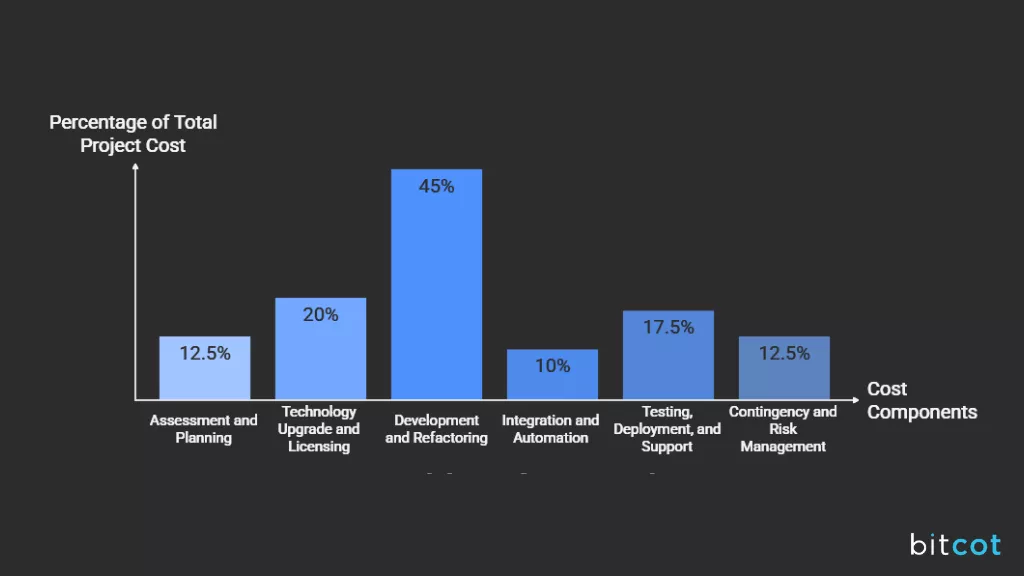
Understanding the costs involved in legacy web application modernization is crucial for planning and budgeting.
The total cost depends on factors like the complexity of your application, chosen modernization approach, technology stack, and required services.
While every project is unique, here’s a breakdown of the typical legacy application modernization cost components involved in modernizing a legacy web application.
1. Assessment and Planning Costs
The first stage of any modernization project involves assessment and strategic planning, typically with the help of a web application development company. Costs here cover evaluating your existing system, analyzing architecture, code, databases, and integrations, and defining the modernization roadmap.
This phase also includes identifying business requirements, estimating effort, and planning risk mitigation. For most businesses, this represents 10-15% of the total project cost but is critical for reducing surprises later. Companies in Riverside invest significantly in this phase to ensure accurate budgeting and timeline estimates.
2. Technology Upgrade and Licensing Costs
Upgrading frameworks, migrating to the cloud, or adopting new technologies often comes with associated licensing and infrastructure costs. This includes subscription fees for cloud platforms, licenses for development tools, or costs for third-party services.
These investments improve scalability, performance, and security, and can represent a significant portion of the modernization budget depending on the size and complexity of the application.
3. Development and Refactoring Costs
Refactoring backend code, rebuilding parts of the frontend, or redeveloping entire modules is usually the largest cost component. It involves developer hours, testing, and iterative improvements.
The scope depends on the chosen modernization approach; light refactoring is less expensive, whereas complete redevelopment requires more time and resources. This stage typically accounts for 40-50% of the total project budget. Businesses in Chula Vista often find this phase requires the most careful resource allocation and timeline management.
4. Integration and Automation Costs
Integration costs cover connecting the application with APIs, third-party tools, and automated workflows. This ensures seamless data flow, improved efficiency, and extended functionality without a full rebuild.
The complexity and number of integrations influence costs, while automation helps reduce manual effort and operational errors. This stage ensures your modernized system is fully functional, scalable, and capable of supporting evolving business processes, including future-proofing with advanced features from AI-powered application development.
5. Testing, Deployment, and Support Costs
Testing, deployment, and ongoing support are essential for a smooth transition. Costs include quality assurance, performance and security testing, phased deployment, and post-launch support. Continuous monitoring, bug fixes, and updates maintain system stability and protect your investment.
This stage typically accounts for 15-20% of the budget and ensures the modernized application performs reliably while meeting user expectations. Organizations in Fremont prioritize comprehensive testing to ensure zero-downtime deployments.
6. Contingency and Risk Management
Every modernization project carries potential risks. Allocating a contingency budget, usually 10–15%, accounts for unforeseen challenges like migration issues, compatibility problems, or design revisions. Risk management ensures that the project stays on schedule and within budget.
Proper planning reduces the likelihood of cost overruns while giving businesses confidence that their modernization initiative will deliver long-term value and measurable ROI.
Partner with Bitcot to Modernize Your Legacy Web Application
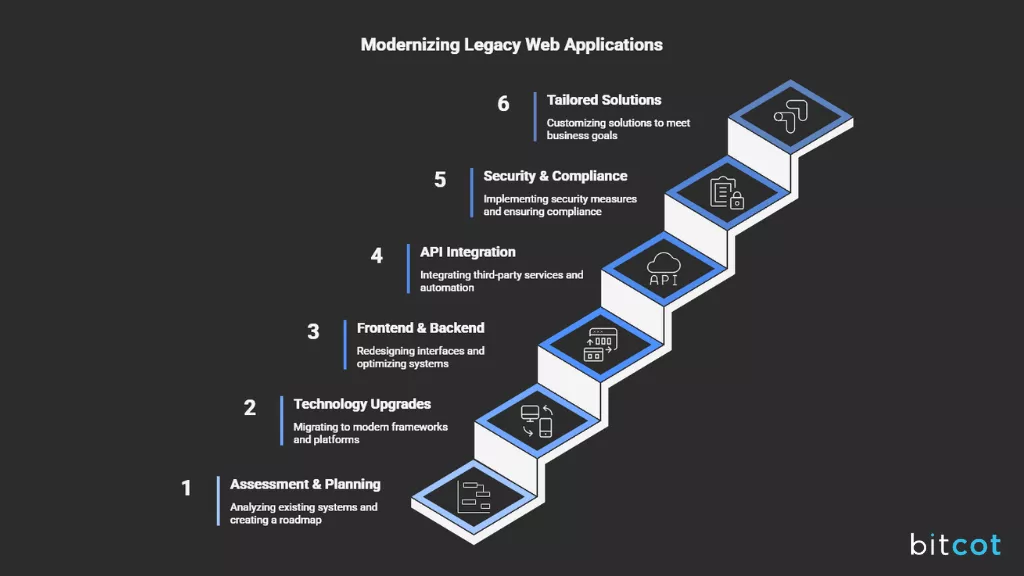
Choosing the right legacy web app modernization agency can make all the difference when modernizing your legacy web application.
At Bitcot, we combine technical expertise in legacy web app modernization development services with strategic guidance to ensure your modernization journey is smooth, cost-effective, and aligned with your business goals.
We provide exceptional cloud application development services to build and migrate legacy systems that are secure, scalable, and high-performing in the cloud. Furthermore, we leverage rapid application development tools to accelerate the transformation process, significantly reducing time-to-market for your modernized applications.
Whether you’re located in Santa Ana or anywhere else across California and the USA, our team is ready to transform your outdated web applications into modern, high-performing solutions.
Here’s how we help businesses transform their outdated systems into modern, scalable web applications:
- Comprehensive Assessment and Planning: We start by thoroughly analyzing your existing application, including its architecture, codebase, databases, and integrations. Our legacy web app modernization developers identify areas for improvement, align modernization strategies with your business objectives, and create a detailed roadmap.
- Expert Technology Upgrades and Migration: Bitcot helps you move to modern frameworks, leverage cloud migration tools and low-code platforms, and ensure optimized infrastructure. Whether it’s replatforming, refactoring, or full redevelopment, we select the right technologies to enhance performance, security, and scalability while minimizing downtime.
- Frontend and Backend Modernization: We redesign user interfaces with modern, responsive frameworks like React, Angular, or Vue and optimize backend systems for better performance and maintainability. This ensures your application is both user-friendly and robust enough to support business growth.
- Seamless API Integration and Automation: Our team integrates third-party services, APIs, and automation workflows to streamline business processes and improve operational efficiency. This helps you unlock new functionality without disrupting existing systems.
- Security, Compliance, and Ongoing Support: We implement advanced security measures, ensure compliance with regulations like GDPR or HIPAA, and provide continuous monitoring and maintenance. Bitcot’s support ensures your modernized application remains reliable, secure, and adaptable to future needs.
- Tailored Solutions for Your Business Goals: Every business is unique. We tailor our modernization approach based on your industry, objectives, and budget to maximize ROI and future-proof your custom application development investment.
Partnering with Bitcot ensures your legacy web application is transformed into a high-performing, secure, and scalable solution that supports your growth and innovation objectives. With our digital transformation services, we guide your business beyond modernization, creating a robust, agile, and competitive platform for the future.
Final Thoughts
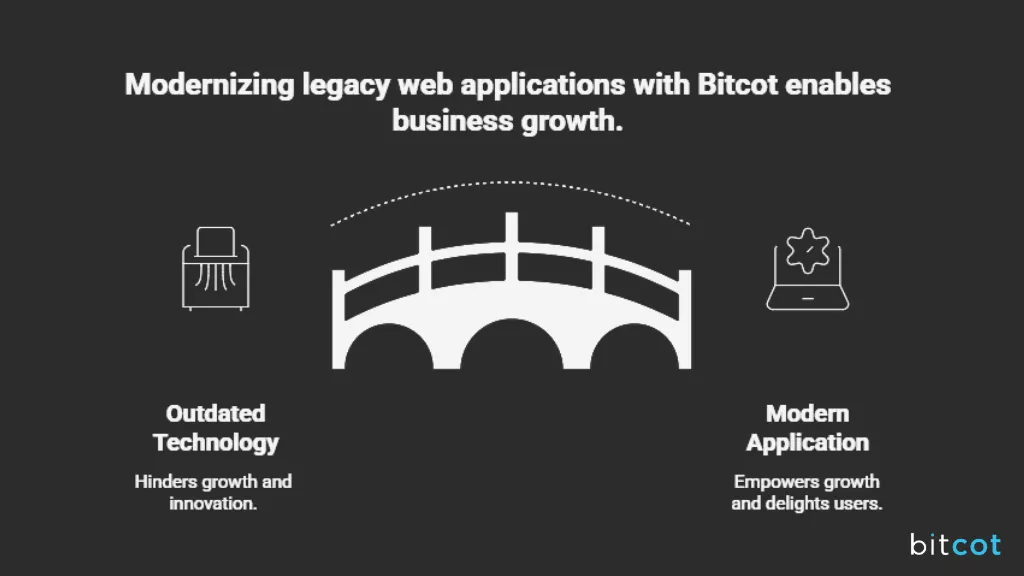
Modernizing a legacy web application isn’t just about updating old technology; it’s about giving your business the tools to grow, adapt, and compete in a digital-first world.
From improving performance and security to enhancing user experience and enabling future scalability, the benefits of modernization are far-reaching. It’s a strategic investment that saves time, reduces technical debt, and opens the door to innovation.
Every modernization journey is unique, and the right approach depends on your application’s complexity, business goals, and long-term vision. With careful planning, expert execution, and ongoing support, even the most outdated systems can be transformed into reliable, high-performing solutions that empower your team and delight your users.
If you’re ready to take the next step, partner with Bitcot. Our team specializes in custom enterprise software development services, helping businesses like yours modernize legacy web applications efficiently and effectively.
We’ll guide you through the entire process, from assessment and planning to development, deployment, and ongoing support, ensuring your modernization project delivers measurable results and long-term value.
Don’t let outdated technology hold your business back. Connect with Bitcot today and start your journey toward a modern, scalable, and future-ready application.



